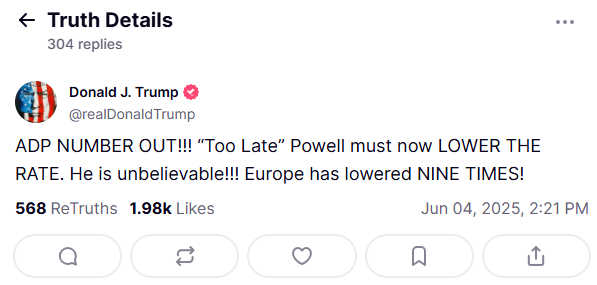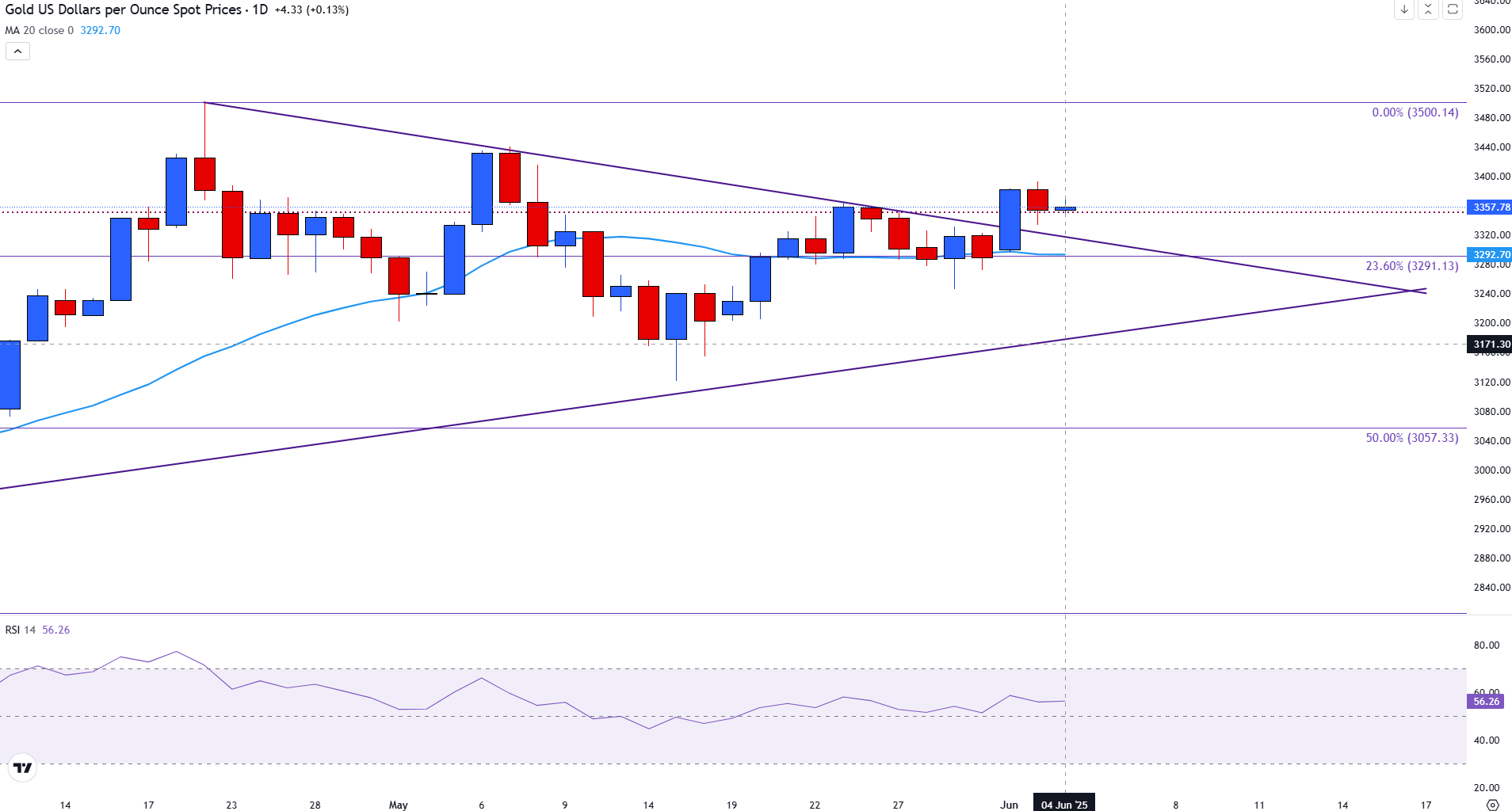- Gold stabilises despite disappointing job numbers for the US private sector.
- ADP data misses expectations, with the May report showing 37,000 jobs added to the US private sector, missing the 115,000 estimate by a large margin.
- US Trump has reacted to the negative ADP figures by posting on Truth Social, blaming Fed Powell for being “Too Late” to cut rates.
- US-China trade tensions remain elevated, with Trump describing China as “extremely hard” to deal with.
- Gold prices whipsaw as psychological support at $3,350 holds.
Gold trades are struggling to gain from a dismal US ADP report, which showed that 37,000 jobs were added to the US private sector in May, far below the estimated number of 115,000.
In response to the disappointing data, US President Trump posted on Truth Social. placing pressure on the Federal Reserve (Fed) to cut rates. With Trump’s remarks stating that the Fed Chair remains “Too Late” to cut rates, markets appear to remain focused on Friday’s Nonfarm Payrolls (NFP report.

Source: Truth Social
ADP data increases doubts over the resiliency of the US labour market ahead of Friday’s NFP report
The report, released by the ADP Research Institute on a monthly basis, is perceived as a leading indicator by many economists, which is released two days before the NFP report. Although Gold prices remained broadly stable on Wednesday, doubts over a US-China trade deal continued to grow, given recent comments from US President Donald Trump.
Trump said on Wednesday that it was “extremely hard” to make a trade deal with Chinese President Xi Jinping, CNBC reports. The comments arise as Washington has fuelled speculation that a call between the two leaders could happen this week.
“I like President XI of China, always have, and always will, but he is VERY TOUGH, AND EXTREMELY HARD TO MAKE A DEAL WITH!!!” Trump wrote on Truth Social.
Chinese Foreign Ministry spokesman, Lin Jian, replied, stating that “China’s principle and position of developing China-US relations is consistent,” Bloomberg reports. The comments suggest that China hasn’t changed its stance since meeting with US representatives last month.
Prospects of a weak trade deal with China, or even no deal, generally benefit safe-haven assets such as Gold.
US 50% tariffs on steel and aluminium are in force
With a 50% tariff rate now in place for aluminum and steel imports into the United States (US), trade relations between the US and its global counterparts remain strained. This provides an additional tailwind for Gold prices and a headwind for major risk assets.
Following positive trade talks between the United States (US) and China in mid-May, which helped ease tensions between the world’s two largest economies, the negotiations appear to have stalled.
With both parties accusing each other of violating the agreement reached in Geneva on May 12, uncertainty surrounding trade relations remains a key driver of Gold prices.
However, Gold’s nemesis appears to be the interest-rate trajectory for global central banks, which are preparing to announce the next round of rate decisions this week. Since investors holding Gold bars or coins do not yield any returns from holding these assets, interest rates are seen as a threat, especially when banks offer higher rates.
On Wednesday, markets are expected to monitor the release of the ADP employment report from the US at 12:15 GMT for clues on how the private sector labor market performed in May. The report comes ahead of the US Nonfarm Payroll release on Friday, which is expected to provide additional insight into the resiliency of the US labour market.
Gold daily digest: China, tariffs, and employment data back in focus
- The Geneva deal had established a 90-day pause on escalating tariffs between China and the US, with the US reducing tariffs on Chinese goods from 145% to 30%, and China lowering tariffs from 125% to 10%. The agreement also included provisions for China to lift restrictions on the export of critical minerals essential to US industries.
- With the European Central Bank (ECB) gearing up for Thursday’s interest rate decision, the release of the Purchasing Managers’ Index (PMI) throughout the morning has provided a mixed picture of the health of the manufacturing and services sectors across the Eurozone. The combination of clear signs of an economic slowdown and slowing inflation is perceived as a warning sign of a potential recession, with spending and demand for goods and services expected to fall.
- For the ECB, inflation data released Tuesday supported market expectations of an additional 25 basis points (bps) rate cut on Thursday.
- Although PMI data from Italy and France came in above estimates, Germany’s data continued to underperform, suggesting that business confidence and the country’s growth outlook remain gloomy. Since Germany is the largest economy in the Eurozone, diminishing growth forecasts place additional pressure on the ECB to provide support to the European economy by continuing to cut interest rates.
- As for the Fed, the CME FedWatch Tool continues to show a 55.6% probability of the US central bank announcing a rate cut in September. A downside surprise in the ADP number may provide temporary relief for Gold as it would increase the chances that the Fed cuts rates in July. For now, the probabilities of such moves aren’t significant.
Gold technical analysis: Prices remain conflicted near $3,350
Gold prices are trading in a consolidative phase above a symmetrical triangle on the daily chart, with the price hovering near $3,355.
Despite a temporary break above the triangle resistance on Monday, prices have failed to gain momentum above the current psychological support level of $3,350.
The 20-day Simple Moving Average (SMA), currently at $3,292, offers additional support.
A break below this level and the triangle base near $3,290 (aligned with the 23.6% Fibonacci retracement of the January-April rally) would expose the $3,057 support zone, marking the midpoint of the aforementioned move.
A deeper decline could extend to $2,804, the 78.6% Fibonacci retracement, if bearish pressure intensifies. The Relative Strength Index (RSI) at 55 supports a mildly bullish bias, but a clear directional move will depend on a breakout from the current range.
Gold daily chart

Fed FAQs
Monetary policy in the US is shaped by the Federal Reserve (Fed). The Fed has two mandates: to achieve price stability and foster full employment. Its primary tool to achieve these goals is by adjusting interest rates.
When prices are rising too quickly and inflation is above the Fed’s 2% target, it raises interest rates, increasing borrowing costs throughout the economy. This results in a stronger US Dollar (USD) as it makes the US a more attractive place for international investors to park their money.
When inflation falls below 2% or the Unemployment Rate is too high, the Fed may lower interest rates to encourage borrowing, which weighs on the Greenback.
The Federal Reserve (Fed) holds eight policy meetings a year, where the Federal Open Market Committee (FOMC) assesses economic conditions and makes monetary policy decisions.
The FOMC is attended by twelve Fed officials – the seven members of the Board of Governors, the president of the Federal Reserve Bank of New York, and four of the remaining eleven regional Reserve Bank presidents, who serve one-year terms on a rotating basis.
In extreme situations, the Federal Reserve may resort to a policy named Quantitative Easing (QE). QE is the process by which the Fed substantially increases the flow of credit in a stuck financial system.
It is a non-standard policy measure used during crises or when inflation is extremely low. It was the Fed’s weapon of choice during the Great Financial Crisis in 2008. It involves the Fed printing more Dollars and using them to buy high grade bonds from financial institutions. QE usually weakens the US Dollar.
Quantitative tightening (QT) is the reverse process of QE, whereby the Federal Reserve stops buying bonds from financial institutions and does not reinvest the principal from the bonds it holds maturing, to purchase new bonds. It is usually positive for the value of the US Dollar.
Managers’ Index (PMI) throughout the morning has provided a mixed picture of the health of the manufacturing and services sectors across

